Saturday, 1 July 2023
Sunday, 6 March 2022
How to Read the Sky at Night : Southern Cross
How to Read the Sky at Night
Practical Astronomy for Date, Time, and Direction Finding
This new page describes some practical astronomy that you can learn quickly — for finding direction, and other things that people could read from the sky in ancient times, before modern technology.
The information on this page at first will relate only to the southern hemisphere, later I might add some northern hemisphere information. There are already a lot of websites about the north hemisphere.
On This Page
The Basics
The Celestial Sphere
Finding the Time and the Date by the Stars
Finding Direction from the Stars
Why Learn Observational Astronomy?
With regards to the subject matter of survival.ark.net.au, there are at least three reasons:
You'll gain practical skills that people used in ancient times, such as how to find time and direction.
Watching the night sky can help a lot to get your mind into more of a peaceful state that's closer to that of ancient people. This somewhat meditative state comes from the slowing down of your thoughts that will happen if you look at the sky enough, and also from using more of your peripheral vision.
These things in the sky can become quite interesting once you start to learn about them them. They are also one of the few things in our lives that's not affected by any of the problems we have in the modern world. No matter what happens to Planet Earth, everything in the distant world of the stars will remain just like it always has. This can become a source of stability and peace.
The Basics
Most people already know that the Sun rises in approximately the east, and sets in (approximately) the west. A good first practical exercise for this is to start to take some notice of where the Sun is throughout the day. Where in the sky is the Sun right now?
If it's night-time right now you might say that the Sun isn't in the sky at all. But it's still somewhere. See if you can point your arm towards where the Sun would be right now, daytime or night-time.
The second thing to know is that everything else "natural" in space, that you can see in the sky (excluding man made objects like satellites and/or any visiting aliens) also moves pretty much in the same fashion as the Sun. That is the Moon, the planets, and most of the stars all approximately rise in the east and set in the west.
The Celestial Sphere
A more accurate way to describe how these sky objects move is to imagine the Earth (and you on the Earth) at the centre of a huge invisible sphere, which makes up the sky. This sphere rotates on the same axis as the Earth does, that is from the North Pole of the Earth to the South Pole.
Imagine that all the stars are stuck to this sphere, and rotate with it around the sky.
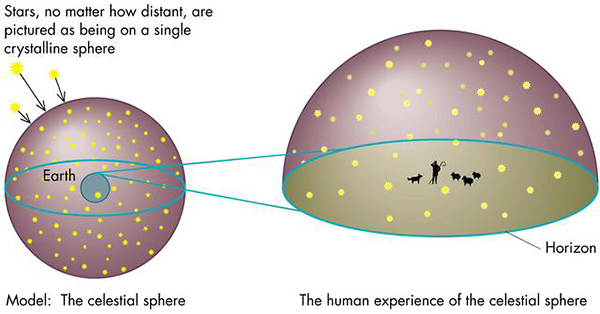
The celestial sphere (and the stars "on" it) rotate around the north and south poles of the sky, called the north and south celestial poles. Unless you are right on the equator you can only ever see one of these poles, and the other one is below the horizon. In the Southern Hemisphere we can see the southern celestial pole.
The horizon is the red line in the diagram below, representing the ground. You can see everything above the red line, and everything below it is below the horizon and invisible.
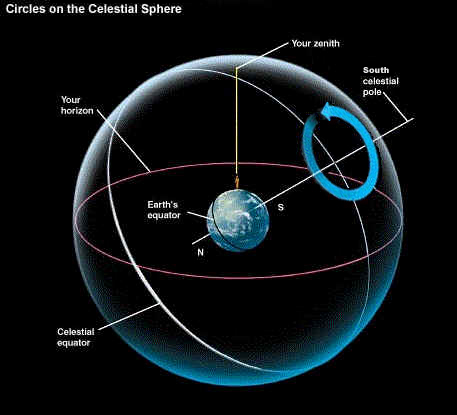
Apart from tiny movements that you need large telescopes to measure, the positions of all the stars as we see them relative to each other, are fixed on this sphere. You can imagine they are glued on, or painted on like in the plastic celestial sphere model shown below. Only the very distant objects, like the stars, are fixed onto the sphere. This includes all the stars (apart from the Sun), plus other objects from astronomy including galaxies, star clusters, nebulae, and the "milky way". Closer objects (within our own solar system) including the Sun, Moon, planets and comets will move relative to this sphere of fixed stars.
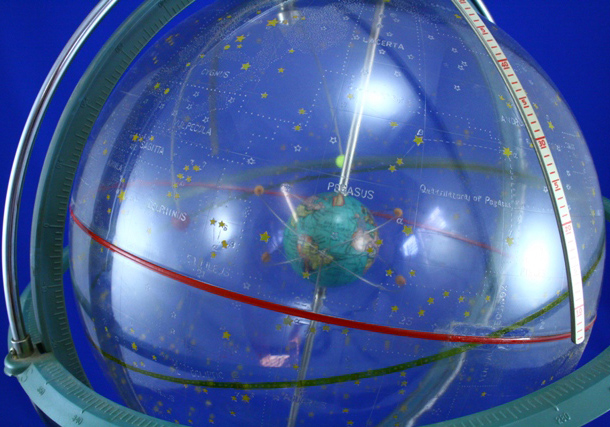
The height of the celestial pole above the horizon (assuming a flat horizon with no hills or buildings etc in the way) will be equal to your latitude. For Sydney this is about 35 degrees. Therefore in Sydney the celestial pole will be about 35 degrees above the horizon — or a bit over 1/3 of the distance from the ground up to the highest point in the sky (i.e. straight up, which is called the zenith, and is 90 degrees above the horizon).
The stars close to the pole will be seen to move clockwise (anticlockwise in the northern hemisphere) in a circle around the pole, and they will be visible all year around, and at any time of the night (as long as there are no clouds in the way). By "close to the pole", specifically this means closer to the pole than your latitude, measured in degrees.
Taking a long exposure time photo of the stars shows how the sky appears to rotate around the celestial pole in the middle.
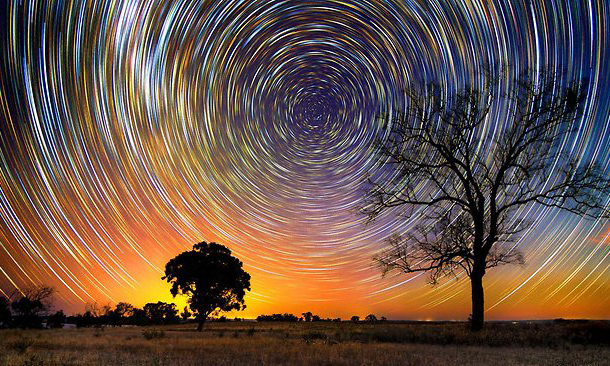
Photo: Bendigo amateur photographer Lincoln Harrison.
From a latitude close to the equator, the celestial pole appears close to the ground as in the photo below from Mount Kilimanjaro.

Photo: dailygalaxy.com.
Finding the Time and the Date by the Stars
The diagram below (from Sydney Observatory) shows how the southern cross moves around the celestial pole (in the centre of the circle) in one night. This is assuming that it starts at the top position about about 6pm, which will only happen around June.
The diagram is slightly wrong because in 12 hours (such as from 6pm to 6am), the cross should move almost exactly 180 degrees. It's actually very close to 180.5 degrees in 12 hours. This is because in one full day, the clock rotates almost exactly 361 degrees, i.e. one degree more than a full circle. Every day the starting position of the clock moves forward by one degree so that in a full year of 365 days, its gone around all the way around and back to where it was a year before.

This diagram (above) can be used to find the approximate time, providing you know what position the cross started from at the start of the night (e.g. at 6pm). The cross moves around this big circle like the hour hand of a massive 24-hour analogue clock which takes up about 1/3 of the entire visible sky. Note that the hour hand on a 24-hour clock moves half as fast as on an ordinary 12-hour clock, so that it takes a full 24 hours to go all the way around.
Reading time from the Southern Cross is like having the clock below stamped onto the sky, but only the hour hand — and with the clock body itself rotated to a position that depends on the date, so that at different dates there will be different starting times at the top of the dial. The diagram under the clock shows how the starting position of the cross (at 8:00 pm) changes over different months. The rotation of this clock body against the sky (and therefore starting position of the cross) happens very slowly, by about 4 minutes on the clock dial per day (which is 1/15th of an hour, or one degree — not very much) , so that it turns a full circle exactly once per year.
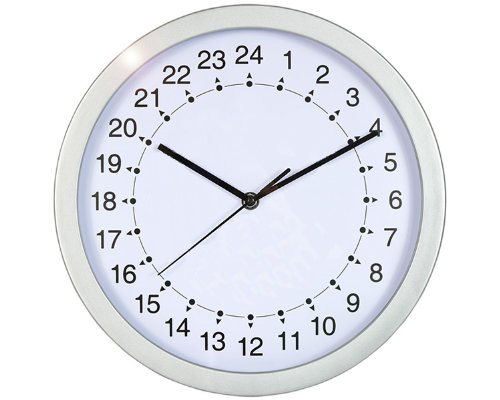
Finding the Date
The next diagram shows how the position of the Southern Cross varies on different dates. The Cross will be in these positions at approximately 8:00pm (this would be 9:00 pm daylight savings time in summer) in the months as labelled below. In any given night it will rotate clockwise, starting from this position at 8:00pm. As an exercise, see if you can find the Southern Cross in the sky tonight (or soon), and compare its position to the diagrams here. Note that these times are independant of what timezone you're in. This is because it's the relative position of the Sun compared to the background stars (on the celesital sphere) that matters, and this is the same anywhere on Earth at any given time of year.
You can use this diagram to find the approximate date, if you view the position of the Southern Cross when you know its about 8:00 pm — i.e. about 2 hours after sunset in midwinter, or shortly after sunset in midsummer (this is 9pm in daylight savings areas). If you had no access to modern technology whatsoever, this method would still work just as well as it does now to tell you, approximately, what month of the year it is.
If its another time than 8pm, you can calculate where the cross would be at 8pm by thinking of how much it would rotate either back or forwards based on how many hours away it is from 8pm. This all sounds complicated but once you get used to looking at the position of the cross often, it becomes second nature. It's easier than learning to tell the time (hours, minutes, and seconds) on an analogue clock.
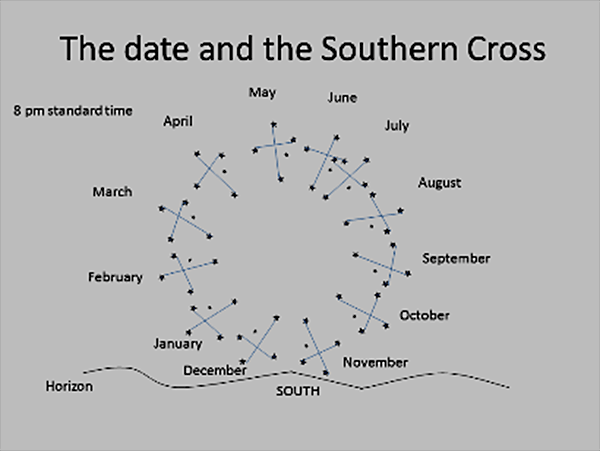
Stars close to the north celestial pole will move in a circle around the north celestial pole, and will never be seen from the southern hemisphere. These are seen in the lower right corner of the picture below (labelled with "Star never rises").
Stars within the leftmost circle are always visible (like the Southern Cross from many southern latitudes) and are called "circumpolar". Stars in between these two circles (not really close to either pole) will rise and set at different times, depending on the time and date. The middle line is called the celestial equator and is the Earth's actual equator projected onto the sky. Stars right on the celestial equator will rise in exactly the east (provided you have a flat horizon) and set in exactly the west.
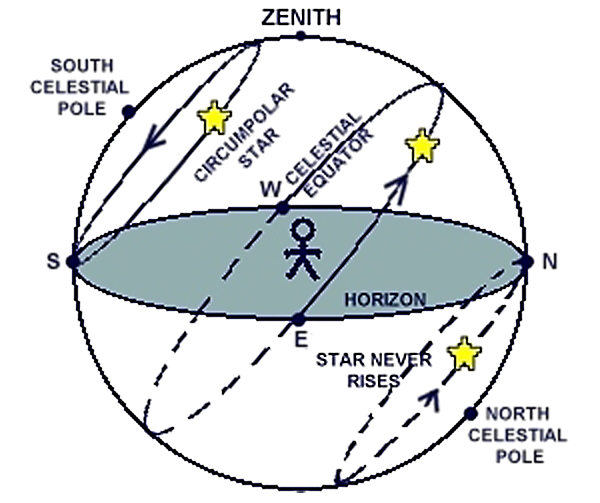
Finding Direction from the Stars
In the Southern Hemisphere, the easiest direction to learn to find from the night sky is south.
Finding South
The easiest way to find south is using the Southern Cross. The position of the cross will vary with the time and date (like in the pictures above with grey backgrounds), but it's long end will always point directly at the southern celestial pole.
There are three ways you can find the pole using the Southern Cross. You can use any one of these (or use two or three to be more accurate):
The southern celestial pole is about 5 times as far away from the cross as the distance from one end of the Southern Cross to the other.
If you draw a line in the direction the cross points, and another line at right angles to the line between the two "pointers", where these lines meet is the pole.
If you can find the bright star Achernar, the pole is halfway between Archenar and the cross.
Once you know where the pole is, south on the horizon is directly below the pole (like the head of the arrow below).

Image by Conger, Cristen. "How to Find True North", HowStuffWorks.com.
To Be Continued...
Coming Soon
Next I'll cover the positions of the Sun, and the seasons, and the position and phases of the Moon, and the months. Also some of the other stars, star maps/charts, the constellations, the planets, and comets.
Recommended Reading
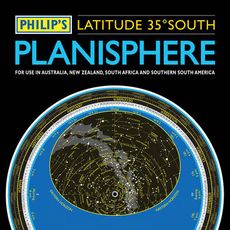 Philip's Planisphere. This practical hour-by-hour tracker of the stars and constellations is an essential travel accessory for astronomy enthusiasts visiting Australia, New Zealand, South Africa or southern South America. Turn the oval panel to the required date and time to reveal the whole sky visible from your location.
Philip's Planisphere. This practical hour-by-hour tracker of the stars and constellations is an essential travel accessory for astronomy enthusiasts visiting Australia, New Zealand, South Africa or southern South America. Turn the oval panel to the required date and time to reveal the whole sky visible from your location. Invaluable for both beginners and advanced observers, Philip's Planisphere (Latitude 35 South) is an essential travel accessory for astronomy enthusiasts visiting Australia, New Zealand, South Africa or southern South America. To use this practical hour-by-hour tracker of the stars and constellations, you simply turn the oval panel to the required date and time to reveal the whole sky visible from your location.The map, by the well-known celestial cartographer Wil Tirion, shows stars down to magnitude 4, plus several deep-sky objects, such as the Pleiades, the Large and Small Magellanic Clouds (LMC and SMC), and the Orion Nebula (M42). Because the planets move round the Sun, their positions in the sky are constantly changing and they cannot be marked permanently on the map; however, the back of the planisphere has tables giving the positions of Venus, Mars, Jupiter and Saturn for every month until 2020.The planisphere is supplied in a full-colour wallet that contains illustrated step-by-step instructions for how to use the planisphere, how to locate planets, and how to work out the time of sunrise or sunset for any day of the year.
It explains all the details that can be seen on the map - the magnitudes of stars, the ecliptic and the celestial coordinates. In addition, the section 'Exploring the skies, season by season' introduces the novice astronomer to the principal celestial objects visible at different times of the year. Major constellations are used as signposts to navigate the night sky, locating hard-to-find stars and some fascinating deep-sky objects. The movement of the stars is also explained.
Tuesday, 30 November 2021
Saturday, 30 October 2021
What Happened: Dr. Jay Bhattacharya on 19 Months of COVID
Recorded on October 13, 2021 From the very beginning of the COVID-19 crisis, Dr. Jay Bhattacharya has been on the front lines of analyzing, studying, and even personally fighting the pandemic. In this wide-ranging interview, Dr. Bhattacharya takes us through how it started, how it spread throughout the world, the efficacy of lockdowns, the development and distribution of the vaccines, and the rise of the Delta variant. He delves into what we got right, what we got wrong, and what we got really wrong. Finally, Dr. Bhattacharya looks to the future and how we will learn to live with COVID rather than trying to extinguish it, and how we might be prepared to deal with another inevitable pandemic that we know will arrive at some point. For further information: https://www.hoover.org/publications/u... Interested in exclusive Uncommon Knowledge content? Check out Uncommon Knowledge on social media!
Tuesday, 5 October 2021
Vaccinating people who have had covid-19: why doesn’t natural immunity count in the US?
This article has a correction. Please see:
Vaccinating people who have had covid-19: why doesn’t natural immunity count in the US? - September 15, 2021
Jennifer Block, freelance journalistAuthor affiliations
writingblock@protonmail.com
Twitter: @writingblock
The US CDC estimates that SARS-CoV-2 has infected more than 100 million Americans, and evidence is mounting that natural immunity is at least as protective as vaccination. Yet public health leadership says everyone needs the vaccine. Jennifer Blockinvestigates
When the vaccine rollout began in mid-December 2020, more than one quarter of Americans—91 million—had been infected with SARS-CoV-2, according to a US Centers for Disease Control and Prevention (CDC) estimate.1 As of this May, that proportion had risen to more than a third of the population, including 44% of adults aged 18-59 (table 1).
Table 1
Estimated total infections in the United States between February 2020 and May 2021*
View popup
View inline
The substantial number of infections, coupled with the increasing scientific evidence that natural immunity was durable, led some medical observers to ask why natural immunity didn’t seem to be factored into decisions about prioritising vaccination.234
“The CDC could say [to people who had recovered], very well grounded in excellent data, that you should wait 8 months,” Monica Gandhi, an infectious disease specialist at University of California San Francisco, told Medpage Today in January. She suggested authorities ask people to “please wait your turn.”4
Others, such as Icahn School of Medicine virologist and researcher Florian Krammer, argued for one dose in those who had recovered. “This would also spare individuals from unnecessary pain when getting the second dose and it would free up additional vaccine doses,” he told the New York Times.5
“Many of us were saying let’s use [the vaccine] to save lives, not to vaccinate people already immune,” says Marty Makary, a professor of health policy and management at Johns Hopkins University.
Still, the CDC instructed everyone, regardless of previous infection, to get fully vaccinated as soon as they were eligible: natural immunity “varies from person to person” and “experts do not yet know how long someone is protected,” the agency stated on its website in January.6 By June, a Kaiser Family Foundation survey found that 57% of those previously infected got vaccinated.7
As more US employers, local governments, and educational institutions issue vaccine mandates that make no exception for those who have had covid-19,8 questions remain about the science and ethics of treating this group of people as equally vulnerable to the virus—or as equally threatening to those vulnerable to covid-19—and to what extent politics has played a role.
The evidence
“Starting from back in November, we’ve had a lot of really important studies that showed us that memory B cells and memory T cells were forming in response to natural infection,” says Gandhi. Studies are also showing, she says, that these memory cells will respond by producing antibodies to the variants at hand.91011
Gandhi included a list of some 20 references on natural immunity to covid in a long Twitter thread supporting the durability of both vaccine and infection induced immunity.12 “I stopped adding papers to it in December because it was getting so long,” she tells The BMJ.
But the studies kept coming. A National Institutes of Health (NIH) funded study from La Jolla Institute for Immunology found “durable immune responses” in 95% of the 200 participants up to eight months after infection.13 One of the largest studies to date, published in Science in February 2021, found that although antibodies declined over 8 months, memory B cells increased over time, and the half life of memory CD8+ and CD4+ T cells suggests a steady presence.9
Real world data have also been supportive.14 Several studies (in Qatar,15 England,16 Israel,17 and the US18) have found infection rates at equally low levels among people who are fully vaccinated and those who have previously had covid-19. Cleveland Clinic surveyed its more than 50 000 employees to compare four groups based on history of SARS-CoV-2 infection and vaccination status.18 Not one of over 1300 unvaccinated employees who had been previously infected tested positive during the five months of the study. Researchers concluded that that cohort “are unlikely to benefit from covid-19 vaccination.” In Israel, researchers accessed a database of the entire population to compare the efficacy of vaccination with previous infection and found nearly identical numbers. “Our results question the need to vaccinate previously infected individuals,” they concluded.17
As covid cases surged in Israel this summer, the Ministry of Health reported the numbers by immunity status. Between 5 July and 3 August, just 1% of weekly new cases were in people who had previously had covid-19. Given that 6% of the population are previously infected and unvaccinated, “these numbers look very low,” says Dvir Aran, a biomedical data scientist at the Technion–Israel Institute of Technology, who has been analysing Israeli data on vaccine effectiveness and provided weekly ministry reports to The BMJ. While Aran is cautious about drawing definitive conclusions, he acknowledged “the data suggest that the recovered have better protection than people who were vaccinated.”
But as the delta variant and rising case counts have the US on edge, renewed vaccination incentives and mandates apply regardless of infection history.8 To attend Harvard University or a Foo Fighters concert or enter indoor venues in San Francisco and New York City, you need proof of vaccination. The ire being directed at people who are unvaccinated is also indiscriminate—and emanating from America’s highest office. In a recent speech to federal intelligence employees who, along with all federal workers, will be required to get vaccinated or submit to regular testing, President Biden left no room for those questioning the public health necessity or personal benefit of vaccinating people who have had covid-19: “We have a pandemic because of the unvaccinated ... So, get vaccinated. If you haven’t, you’re not nearly as smart as I said you were.”
Staying firm
Other countries do give past infection some immunological currency. Israel recommends that people who have had covid-19 wait three months before getting one mRNA vaccine dose and offers a “green pass” (vaccine passport) to those with a positive serological result regardless of vaccination.19 In the European Union, people are eligible for an EU digital covid certificate after a single dose of an mRNA vaccine if they have had a positive test result within the past six months, allowing travel between 27 EU member states.20 In the UK, people with a positive polymerase chain reaction (PCR) test result can obtain the NHS covid pass up until 180 days after infection.21
Although it’s too soon to say whether these systems are working smoothly or mitigating spread, the US has no category for people who have been infected. The CDC still recommends a full vaccination dose for all, which is now being mirrored in mandates. A spokesperson told The BMJ that “the immune response from vaccination is more predictable” and that based on current evidence, antibody responses after infection “vary widely by individual,” though studies are ongoing to “learn how much protection antibodies from infection may provide and how long that protection lasts.”
In June, Peter Marks, director of the Food and Drug Administration’s Center for Biologics Evaluation and Research, which regulates vaccines, went a step further and stated: “We do know that the immunity after vaccination is better than the immunity after natural infection.” In an email, an FDA spokesperson said Marks’s comment was based on a laboratory study of the binding breadth of Moderna vaccine induced antibodies.22The research did not measure any clinical outcomes. Marks added, referring to antibodies, that “generally the immunity after natural infection tends to wane after about 90 days.”23
“It appears from the literature that natural infection provides immunity, but that immunity is seemingly not as strong and may not be as long lasting as that provided by the vaccine,” Alfred Sommer, dean emeritus of the Johns Hopkins Bloomberg School of Public Health tells The BMJ.
But not everyone agrees with this interpretation. “The data we have right now suggests that there probably isn’t a whole lot of difference” in terms of immunity to the spike protein, says Matthew Memoli, director of the Laboratory of Infectious Diseases Clinical Studies at the NIH, who spoke to The BMJ in a personal capacity.
Memoli highlights real world data such as the Cleveland Clinic study18 and points out that while “vaccines are focused on only that tiny portion of immunity that can be induced” by the spike, someone who has had covid-19 was exposed to the whole virus, “which would likely offer a broader based immunity” that would be more protective against variants. The laboratory study offered by the FDA22 “only has to do with very specific antibodies to a very specific region of the virus [the spike],” says Memoli. “Claiming this as data supporting that vaccines are better than natural immunity is shortsighted and demonstrates a lack of understanding of the complexity of immunity to respiratory viruses.”
Antibodies
Much of the debate pivots on the importance of sustained antibody protection. In April, Anthony Fauci told US radio host Maria Hinajosa that people who have had covid-19 (including Hinajosa) still need to be “boosted” by vaccination because “your antibodies will go sky high.”
“That’s still what we’re hearing from Dr Fauci—he’s a strong believer that higher antibody titres are going to be more protective against the variants,” says Jeffrey Klausner, a clinical professor of preventive medicine at the University of Southern California and former CDC medical officer, who has spoken out in favour of treating prior infection as equivalent to vaccination, with “the same societal status.”3 Klausner conducted a systematic review of 10 studies on reinfection and concluded that the “protective effect” of a previous infection “is high and similar to the protective effect of vaccination.”
In vaccine trials, antibodies are higher in participants who were seropositive at baseline than in those who were seronegative.24 However, Memoli questions the importance: “We don’t know that that means it’s better protection.”
Former CDC director Tom Frieden, a proponent of universal vaccination, echoes that uncertainty: “We don’t know that antibody level is what determines protection.”
Gandhi and others have been urging reporters away from antibodies as the defining metric of immunity. “It is accurate that your antibodies will go down” after natural infection, she says—that’s how the immune system works. If antibodies didn’t clear from our bloodstream after we recover from a respiratory infection, “our blood would be thick as molasses.”
“The real memory in our immune system resides in the [T and B] cells, not in the antibodies themselves,” says Patrick Whelan, a paediatric rheumatologist at University of California, Los Angeles. He points out that his sickest covid-19 patients in intensive care, including children with multisystem inflammatory syndrome, have “had loads of antibodies ... So the question is, why didn’t they protect them?”
Antonio Bertoletti, a professor of infectious disease at Duke-NUS Medical School in Singapore, has conducted research that indicates T cells may be more important than antibodies. Comparing the T cell response in people with symptomatic versus asymptomatic covid-19, Bertoletti’s team found them to be identical, suggesting that the severity of infection does not predict strength of resulting immunity and that people with asymptomatic infections “mount a highly functional virus specific cellular immune response.”25
Already complicated rollout
While some argue that the pandemic strategy should not be “one size fits all,” and that natural immunity should count, other public health experts say universal vaccination is a more quantifiable, predictable, reliable, and feasible way to protect the population.
Frieden told The BMJ that the question of leveraging natural immunity is a “reasonable discussion,” one he had raised informally with the CDC at start of rollout. “I thought from a rational standpoint, with limited vaccine available, why don’t you have the option” for people with previous infection to defer until there was more supply, he says. “I think that would have been a rational policy. It would have also made rollout, which was already too complicated, even more complicated.”
Most infections were never diagnosed, Frieden points out, and many people may have assumed they had been infected when they hadn’t. Add to that false positive results, he says. Had the CDC given different directives and vaccine schedules based on prior infection, it “wouldn’t have done much good and might have done some harm.”
Klausner, who is also a medical director of a US testing and vaccine distribution company, says he initiated conversations about offering a fingerprick antibody screen for people with suspected exposure before vaccination, so that doses could be used more judiciously. But “everyone concluded it was just too complicated.”
“It’s a lot easier to put a shot in their arm,” says Sommer. “To do a PCR test or to do an antibody test and then to process it and then to get the information to them and then to let them think about it—it’s a lot easier to just give them the damn vaccine.” In public health, “the primary objective is to protect as many people as you can,” he says. “It’s called collective insurance, and I think it’s irresponsible from a public health perspective to let people pick and choose what they want to do.”
But Klausner, Gandhi, and others raise the question of fairness for the millions of Americans who already have records of positive covid test results—the basis for “recovered” status in Europe—and equity for those at risk who are waiting to get their first dose (an argument being raised anew as US officials announce boosters while the virus spreads in countries lacking vaccine supply). For people who did not have a confirmed positive result but suspected previous infection, reliable antibody tests have been accessible “at least since April,” according to Klausner, though in May, the FDA announced that “antibody tests should not be used to evaluate a person’s level of immunity or protection from covid-19 at any time.”26
Unlike Europe, the US doesn’t have a national certificate or vaccination requirement, so defenders of natural immunity have simply advocated for more targeted recommendations and screening availability—and that mandates allow for exemptions. Logistics aside, a recognition of existing immunity would have fundamentally changed the target vaccination calculations and would also affect the calculations on boosters. “As we continued to put effort into vaccination and set targets, it became apparent to me that people were forgetting that herd immunity is formed by both natural immunity and vaccine immunity,” says Klausner.
Gandhi thinks logistics is only part of the story. “There’s a very clear message out there that ‘OK, well natural infection does cause immunity but it’s still better to get vaccinated,’ and that message is not based on data,” says Gandhi. “There’s something political going on around that.”
Politics of natural immunity
Early in the pandemic, the question of natural immunity was on the mind of Ezekiel Emanuel, a bioethicist at the University of Pennsylvania and senior fellow at the liberal think tank Center for American Progress, who later became a covid adviser to President Biden. He emailed Fauci before dawn on 4 March 2020. Within a few hours, Fauci wrote back: “you would assume that their [sic] would be substantial immunity post infection.”27
That was before natural immunity started to be promoted by Republic politicians. In May 2020, Kentucky senator and physician Rand Paul asserted that since he already had the virus, he didn’t need to wear a mask. He has been the most vocal since, arguing that his immunity exempted him from vaccination. Wisconsin senator Ron Johnson and Kentucky representative Thomas Massie have also spoken out. And then there was President Trump, who tweeted last October that his recovery from covid-19 rendered him “immune” (which Twitter labelled “misleading and potentially harmful information”).
Another polarising factor may have been the Great Barrington declaration of October 2020, which argued for a less restrictive pandemic strategy that would help build herd immunity through natural infections in people at minimal risk.28 The John Snow memorandum, written in response (with signatories including Rochelle Walensky, who went on to head the CDC), stated “there is no evidence for lasting protective immunity to SARS-CoV-2 following natural infection.”29 That statement has a footnote to a study of people who had recovered from covid-19, showing that blood antibody levels wane over time.
More recently, the CDC made headlines with an observational study aiming to characterise the protection a vaccine might give to people with past infections. Comparing 246 Kentuckians who had subsequent reinfections with 492 controls who had not, the CDC concluded that those who were unvaccinated had more than twice the odds of reinfection.30 The study notes the limitation that the vaccinated are “possibly less likely to get tested. Therefore, the association of reinfection and lack of vaccination might be overestimated.” In announcing the study, Walensky stated: “If you have had covid-19 before, please still get vaccinated.”31
“If you listen to the language of our public health officials, they talk about the vaccinated and the unvaccinated,” Makary tells The BMJ. “If we want to be scientific, we should talk about the immune and the non-immune.” There’s a significant portion of the population, Makary says, who are saying, “‘Hey, wait, I’ve had [covid].’ And they’ve been blown off and dismissed.”
Different risk-benefit analysis?
For Frieden, vaccinating people who have already had covid-19 is, ultimately, the most responsible policy right now. “There’s no doubt that natural infection does provide significant immunity for many people, but we’re operating in an environment of imperfect information, and in that environment the precautionary principle applies—better safe than sorry.”
“In public health you are always dealing with some level of unknown,” says Sommer. “But the bottom line is you want to save lives, and you have to do what the present evidence, as weak as it is, suggests is the strongest defence with the least amount of harm.”
But others are less certain.
“If natural immunity is strongly protective, as the evidence to date suggests it is, then vaccinating people who have had covid-19 would seem to offer nothing or very little to benefit, logically leaving only harms—both the harms we already know about as well as those still unknown,” says Christine Stabell Benn, vaccinologist and professor in global health at the University of Southern Denmark. The CDC has acknowledged the small but serious risks of heart inflammation and blood clots after vaccination, especially in younger people. The real risk in vaccinating people who have had covid-19 “is of doing more harm than good,” she says.
A large study in the UK32 and another that surveyed people internationally33 found that people with a history of SARS-CoV-2 infection experienced greater rates of side effects after vaccination. Among 2000 people who completed an online survey after vaccination, those with a history of covid-19 were 56% more likely to experience a severe side effect that required hospital care.33
Patrick Whelan, of UCLA, says the “sky high” antibodies after vaccination in people who were previously infected may have contributed to these systemic side effects. “Most people who were previously ill with covid-19 have antibodies against the spike protein. If they are subsequently vaccinated, those antibodies and the products of the vaccine can form what are called immune complexes,” he explains, which may get deposited in places like the joints, meninges, and even kidneys, creating symptoms.
Other studies suggest that a two dose regimen may be counterproductive.34 One found that in people with past infections, the first dose boosted T cells and antibodies but that the second dose seemed to indicate an “exhaustion,” and in some cases even a deletion, of T cells.34 “I’m not here to say that it’s harmful,” says Bertoletti, who coauthored the study, “but at the moment all the data are telling us that it doesn’t make any sense to give a second vaccination dose in the very short term to someone who was already infected. Their immune response is already very high.”
Despite the extensive global spread of the virus, the previously infected population “hasn’t been studied well as a group,” says Whelan. Memoli says he is also unaware of any studies examining the specific risks of vaccination for that group. Still, the US public health messaging has been firm and consistent: everyone should get a full vaccine dose.
“When the vaccine was rolled out the goal should have been to focus on people at risk, and that should still be the focus,” says Memoli. Such risk stratification may have complicated logistics, but it would also require more nuanced messaging. “A lot of public health people have this notion that if the public is told that there’s even the slightest bit of uncertainty about a vaccine, then they won’t get it,” he says. For Memoli, this reflects a bygone paternalism. “I always think it’s much better to be very clear and honest about what we do and don’t know, what the risks and benefits are, and allow people to make decisions for themselves.”
Footnotes
Competing interests: I have read and understood BMJ policy on declaration of interests and have no relevant interests to declare.
Provenance and peer review: Commissioned; externally peer reviewed.
This article is made freely available for use in accordance with BMJ's website terms and conditions for the duration of the covid-19 pandemic or until otherwise determined by BMJ. You may use, download and print the article for any lawful, non-commercial purpose (including text and data mining) provided that all copyright notices and trade marks are retained.https://bmj.com/coronavirus/usage
References
↵
CDC. Estimated disease burden of COVID-19. Feb-Sep 2020. https://web.archive.org/web/20210115184811/https://www.cdc.gov/coronavirus/2019-ncov/cases-updates/burden.html
↵
We’ll have herd immunity by April. Wall Street Journal 2021 https://www.wsj.com/articles/well-have-herd-immunity-by-april-11613669731
↵
Klausner J. Op-Ed: Quit ignoring natural covid. Medpage Today 2021 May 28. Immunity. https://www.medpagetoday.com/infectiousdisease/covid19/92836
↵
Natural immunity to covid-19: taking politics out of science. Monica Gandhi, MD, talks to Marty Makary, MD, about the data beyond the debate. Medpage Today 2021. https://www.medpagetoday.com/infectiousdisease/covid19/90894
↵
Had covid? You may only need one dose of vaccine, study says. New York Times 2021 Feb 8. https://www.nytimes.com/2021/02/01/health/have-you-had-covid-19-coronavirus.html
↵
CDC. Frequently asked questions about covid-19 vaccination. 25 Jan 2021. https://web.archive.org/web/20210131060730/https://www.cdc.gov/coronavirus/2019-ncov/vaccines/faq.html
↵
KFF COVID-19 Vaccine Monitor: June 2021.https://www.kff.org/coronavirus-covid-19/poll-finding/kff-covid-19-vaccine-monitor-june-2021/
↵
Block J. US college covid-19 vaccine mandates don’t consider immunity or pregnancy, and may run foul of the law. BMJ2021;373:n1397. doi:10.1136/bmj.n1397 pmid:34078619
FREE Full TextGoogle Scholar
↵
Dan JM,
Mateus J,
Kato Y,
et al. Immunological memory to SARS-CoV-2 assessed for up to 8 months after infection. Science2021;371:eabf4063. doi:10.1126/science.abf4063 pmid:33408181
Abstract/FREE Full TextGoogle Scholar
↵
Redd AD, Nardin A, Kared H, et al. CD8+ T-cell responses in covid-19 convalescent individuals target conserved epitopes from multiple prominent SARS-CoV-2 circulating variants. Open Forum Infectious Diseases 2021;8: ofab143.
↵
Tarke A,
Sidney J,
Methot N,
et al. Negligible impact of SARS-CoV-2 variants on CD4+ and CD8+ T cell reactivity in COVID-19 exposed donors and vaccines.bioRxiv 2021.02.27.433180. [Preprint.] doi:10.1101/2021.02.27.433180
Abstract/FREE Full TextGoogle Scholar
↵
Ghandi M. Twitter post 8 May 2021. [REMOVED IF= FIELD]https://twitter.com/MonicaGandhi9/status/1391139927442690048
↵
NIH. Lasting immunity found after recovery from COVID-19. 2021. https://www.nih.gov/news-events/nih-research-matters/lasting-immunity-found-after-recovery-covid-19#main-content
↵
O Murchu E,
Byrne P,
Carty PG,
et al. Quantifying the risk of SARS-CoV-2 reinfection over time. Rev Med Virol2021:e2260.pmid:34043841
PubMedGoogle Scholar
↵
Bertollini R,
Chemaitelly H,
Yassine HM,
Al-Thani MH,
Al-Khal A,
Abu-Raddad LJ. Associations of vaccination and of prior infection with positive PCR test results for SARS-CoV-2 in airline passengers arriving in Qatar. JAMA2021;326:185-8.doi:10.1001/jama.2021.9970 pmid:34106201
CrossRefPubMedGoogle Scholar
↵
Hall VJ,
Foulkes S,
Charlett A,
et al.,
SIREN Study Group. SARS-CoV-2 infection rates of antibody-positive compared with antibody-negative health-care workers in England: a large, multicentre, prospective cohort study (SIREN). Lancet2021;397:1459-69. doi:10.1016/S0140-6736(21)00675-9 pmid:33844963
CrossRefPubMedGoogle Scholar
↵
Goldberg Y,
Mandel M,
Woodbridge Y, et al. Protection of previous SARS-CoV-2 infection is similar to that of BNT162b2 vaccine protection: A three-month nationwide experience from Israel. [Preprint.] medRxiv2021.04.20.21255670.doi:10.1101/2021.04.20.21255670
Abstract/FREE Full TextGoogle Scholar
↵
Shrestha NK,
Burke PC,
Niowacki AS,
Terpeluk P,
Gordon SM. Necessity of COVID-19 vaccination in previously infected individuals.[Preprint.] medRxiv2021.06.01.21258176; doi:10.1101/2021.06.01.21258176
CrossRefGoogle Scholar
↵
What is a green pass? https://corona.health.gov.il/en/directives/green-pass-info/
↵
Questions and answers —EU digital covid certificate. Jun 2021. https://ec.europa.eu/commission/presscorner/detail/en/QANDA_21_2781
↵
UK Department of Health and Social Care. Who can get an NHS COVID Pass in England. 26 Aug 2021. https://www.gov.uk/guidance/nhs-covid-pass#who-can-get-an-nhs-covid-pass-in-england
↵
Greaney AJ,
Loes AN,
Gentles LE,
et al. Antibodies elicited by mRNA-1273 vaccination bind more broadly to the receptor binding domain than do those from SARS-CoV-2 infection. Sci Transl Med2021;13:eabi9915.doi:10.1126/scitranslmed.abi9915 pmid:34103407
Abstract/FREE Full TextGoogle Scholar
↵
Janet Woodcock and Peter Marks discuss the suggested increased risks of myocarditis and pericarditis following covid-19 vaccination. 6 Jul 2021. https://www.youtube.com/watch?v=_j8ziaOpl7o&t=1724s
↵
FDA. Pfizer-BioNTech covid-19 vaccine EUA amendment review memorandum. Table 9. 2021. https://www.fda.gov/media/148542/download#page=19
↵
Le Bert N,
Clapham HE,
Tan AT,
et al. Highly functional virus-specific cellular immune response in asymptomatic SARS-CoV-2 infection. J Exp Med2021;218:e20202617. . doi:10.1084/jem.20202617 pmid:33646265
CrossRefPubMedGoogle Scholar
↵
FDA. Antibody testing is not currently recommended to assess immunity after covid-19 vaccination: FDA safety communication, 19 May 2021. https://www.fda.gov/medical-devices/safety-communications/antibody-testing-not-currently-recommended-assess-immunity-after-covid-19-vaccination-fda-safety
↵
Anthony Fauci emails. 4 Mar 2021. https://assets.documentcloud.org/documents/20793561/leopold-nih-foia-anthony-fauci-emails.pdf
↵
Great Barrington declaration, https://gbdeclaration.org/
↵
John Snow memorandum. https://www.johnsnowmemo.com/john-snow-memo.html
↵
Cavanaugh AM,
Spicer KB,
Thoroughman D,
Glick C,
Winter K. Reduced risk of reinfection with SARS-CoV-2 after COVID-19 vaccination—Kentucky, May-June 2021. MMWR Morb Mortal Wkly Rep2021;70:1081-3.doi:10.15585/mmwr.mm7032e1 pmid:34383732
CrossRefPubMedGoogle Scholar
↵
CDC. New CDC Study: Vaccination offers higher protection than previous covid-19 infection. Press release, 6 Aug 2021. https://www.cdc.gov/media/releases/2021/s0806-vaccination-protection.html
↵
Menni C,
Klaser K,
May A,
et al. Vaccine side-effects and SARS-CoV-2 infection after vaccination in users of the COVID Symptom Study app in the UK: a prospective observational study. Lancet Infect Dis2021;21:939-49. doi:10.1016/S1473-3099(21)00224-3 pmid:33930320
CrossRefPubMedGoogle Scholar
↵
Mathioudakis AG,
Ghrew M,
Ustianowski A,
et al. Self-reported real-world safety and reactogenicity of covid-19 vaccines: a vaccine recipient survey. Life (Basel)2021;11:249. doi:10.3390/life11030249 pmid:33803014
CrossRefPubMedGoogle Scholar
↵
Camara C,
Lozano-Ojalvo D,
Lopez-Grandados E. Differential effects of the second SARS-CoV-2 mRNA vaccine dose on T cell immunity in naïve and COVID-19 recovered individuals. Cell Rep 2021;36:109570. doi:10.1016/j.celrep.2021.109570
CrossRefGoogle ScholarView Abstract
Sunday, 26 September 2021
Natural Immunity
Many questions remain about both natural and vaccine induced immunity to SARS-CoV-2. Chris Baraniuk reviews what we know so far
How long does covid-19 immunity last?
This is difficult to say definitively. When the body’s immune system responds to an infection, it isn’t always clear how long any immunity that develops will persist. Covid-19 is a very new disease, and scientists are still working out precisely how the body fends off the virus.
There is reason to think that immunity could last for several months or a couple of years, at least, given what we know about other viruses and what we have seen so far in terms of antibodies in patients with covid-19 and in people who have been vaccinated. But getting to a ballpark figure, yet alone putting an exact number on it, is difficult, and the results of immunological studies of covid-19 vary. One reason for this is confounding factors that scientists do not yet fully understand—in some studies, for example, the longevity of antibodies targeting the spike of SARS-CoV-2 is shorter than one might expect.1 We lack clear data to understand whether this is a problem for covid-19.
Immunity is also determined by other factors besides antibodies, such as T and B cell memory, which some studies estimate could last for years.2 And immunity is induced differently by natural infection versus vaccination, so one can’t just combine studies to arrive at a definitive figure.
How long do antibodies against covid-19 stay in the body?
Data indicate that neutralising antibodies last for several months in patients with covid-19 but gently fall in number over time. One study, published in the journal Immunity, of 5882 people who had recovered from covid-19 infection, found that antibodies were still present in their blood five to seven months after illness.3 This was true for mild and severe cases, though people with severe disease ended up with more antibodies overall.
All of the vaccines approved so far produce strong antibody responses. The study group for the Moderna vaccine reported in April that participants in an ongoing clinical trial had high levels of antibodies six months after their second dose.4 A study in the Lancet found that the Oxford-AstraZeneca vaccine induced high antibodies with “minimal waning” for three months after a single dose.5
Neutralising antibodies are expected to decline in number over time, says Timothée Bruel, a researcher at the Pasteur Institute, given what we know about the immune response to other infections. In April, Bruel and colleagues published a paper in Cell Reports Medicine that looked at antibody levels and functions in people who had experienced symptomatic or asymptomatic covid-19.6 Both types of participant possessed polyfunctional antibodies, which can neutralise the virus or assist in killing infected cells, among other things.
This broad response, says Bruel, might contribute to longer lasting protection overall, even if neutralising capabilities wane. A modelling study published in Nature Medicine examined the decay of neutralising antibodies for seven covid-19 vaccines. The authors argued that “even without immune boosting, a significant proportion of individuals may maintain long-term protection from severe infection by an antigenically similar strain, even though they may become susceptible to mild infection.”
More research is needed, however, to determine exactly how the body fights off SARS-CoV-2 and for how long polyfunctional antibodies might play a defensive role after infection or vaccination.
What about T and B cell responses?
T and B cells have a central role in fighting off infections and, crucially, in establishing long term immunity. Some T and B cells act as memory cells, persisting for years or decades, primed and ready to reignite a broader immune response should their target pathogen arrive in the body again. It’s these cells that make truly long term immunity possible.
A study published in February in Science assessed the proliferation of antibodies as well as T and B cells in 188 people who had had covid-19.7 Although antibody titres fell, memory T and B cells were present up to eight months after infection. Another study in a comparably sized cohort reported similar results in a preprint posted to MedRxiv on 27 April.8
Monica Gandhi, an infectious disease doctor and professor of medicine at the University of California San Francisco, says we have evidence that T and B cells can confer lifelong protection against certain diseases similar to covid-19. A well known Nature paper from 2008 found that 32 people born in 1915 or earlier still retained some level of immunity against the 1918 flu strain, 90 years hence.9 “That is really profound,” she says.
A paper published in July 2020 in Nature found that 23 patients who had recovered from severe acute respiratory syndrome still possessed CD4 and CD8 T cells, 17 years after infection with SARS-CoV-1 in the 2003 epidemic.10 What’s more, some of those cells showed cross reactivity against SARS-CoV-2, despite the participants reporting no history of having covid-19.
But again, these are early studies and we still lack definitive conclusions about the role of T and B cells in covid-19 immunity. There’s a conundrum, for example, in knowing that T cells help B cells to rapidly make high affinity antibodies on re-exposure. How much does it matter that serum antibodies have a short life and wane rapidly, if the cells making them are established and ready to go?
How does natural immunity compare with vaccine induced immunity?
Various studies have shown that an immune response involving memory T and B cells emerges after covid-19 infection.11 But people’s immune systems tend to respond in very different ways to natural infection,12notes Eleanor Riley, professor of immunology and infectious disease at the University of Edinburgh. “The immune response after vaccination is much more homogenous,” she says, adding that most people generally have a really good response after vaccination. Data from the clinical trials of the leading vaccine candidates have found T and B cell reactivity.13
Does vaccination make a difference to those who have already had covid-19?
There is some evidence that vaccination can sharpen immunity in people who have previously been infected with SARS-CoV-2 and recovered. A letter published in the Lancet in March discussed an experiment in which 51 healthcare workers in London were given a single dose of the Pfizer vaccine. Half of the healthcare workers had previously recovered from covid-19 and it was they who experienced the greatest boost in antibodies—more than 140-fold from peak pre-vaccine levels—against the virus’s spike protein.14
Is there any difference in vaccine induced immunity between the first and second doses?
It’s difficult to get a sense of the entire immune response after one dose of vaccine versus two, but multiple studies have investigated antibody levels at different stages of dosing. One preprint study from researchers at University College London involving more than 50 000 participants found that 96.4% were antibody positive one month after their first dose of either the Pfizer or AstraZeneca vaccines, and 99.1% were antibody positive between seven and 14 days after their second dose.15 Median antibody levels changed slightly up to two weeks after the second dose, at which point they rocketed.
Another study, also a preprint by researchers in the UK, evaluated the difference in peak antibody levels among 172 people over 80 who received the Pfizer vaccine.16 Those who had no previous record of covid-19 infection had 3.5 times more antibodies at their peak if they received their second dose 12 weeks later rather than three weeks later. However, median T cell levels were 3.6 times lower in those who had the longer dosage interval (the authors note that the relatively low T cell responses in both cohorts in the study may be because of their age). This again shows how early we are in our understanding of the virus and immunity to it.
How does immunity affect reinfection?
Detected cases of reinfection are rare.17 Riley thinks that, even if people become infected after vaccination or an initial natural infection, they will probably experience only a mild illness at worst. (Note, however, that this does not necessarily mean they cannot transmit the virus even if they have mild or no symptoms.)
Will covid-19 vaccine boosters be necessary?
Albert Bourla, the chief executive of Pfizer, has said that a booster dose will “likely” be required within 12 months of the second dose.18 There are understandable reasons for this. Riley points out that older people, for example, might have weaker immune responses, so they could be threatened by a rise in virus transmission during the winter. Boosters might also be necessary to heighten immunity against emerging variants of SARS-CoV-2, she adds.
Gandhi argues that SARS-CoV-2 is known to mutate relatively slowly, and early studies have found there is still good cross reactivity against new versions of the virus.19 She thinks it is unlikely that the immunity induced by the original vaccines won’t be enough to tackle new variants.
An article published in Science in March 2021 reviewed the evidence so far and concluded that the currently available vaccines give sufficient protection against extant and foreseeable variants.20“Ultimately, the best defence against emergence of further variants of concern is a rapid, global, vaccination campaign—in concert with other public health measures to block transmission,” the authors concluded. “A virus that cannot transmit and infect others has no chance to mutate.”
Gandhi agrees: “Clamping down [on] this pandemic when we know we have the tools to do so worldwide is our first priority, as opposed to thinking about boosters that may not be needed for rich countries.”
Friday, 24 September 2021
Another Natural immunity article
Jaw-Dropping Academic Study Shows Natural Immunity Superior to COVID Vaccine
Posted on 08/26/2021
The global debate of COVID mRNA vaccine mandates and passports has ignited social media, policymakers, and policies that impact just nearly every aspect of public life. A number of major studies by universities are confirming basic biology principles about the power of natural immunity. Researchers at Maccabi Healthcare and Tel Aviv University compared the outcomes of over 76,000 Israelis in three groups. Keep in mind, the study is only published as a preprint at this stage and has not been peer reviewed. There was no external funding for the project.
The groups in the study were:
1. the doubly vaccinated (with the Pfizer vaccine)
2. Previously COVID infected but unvaccinated
3. Previously COVID infected with only a single vaccine dose
Comparing SARS-CoV-2 natural immunity to vaccine-induced immunity: reinfections versus breakthrough infections
Sivan Gazit, Roei Shlezinger, Galit Perez, Roni Lotan, Asaf Peretz, Amir Ben-Tov, Dani Cohen, Khitam Muhsen, Gabriel Chodick, Tal Patalon
Link to study: https://www.medrxiv.org/content/10.1101/2021.08.24.21262415v1
The Israeli researchers discovered that immunity acquired through infection from COVID-19 is superior to immunity from the Pfizer-BioNTech vaccine. The study also found that fully-vaccinated but uninfected people were significantly more likely to have a “breakthrough” COVID infection than people who had previously been infected and recovered from the disease.
“This study demonstrated that natural immunity confers longer lasting and stronger protection against infection, symptomatic disease and hospitalisation caused by the Delta variant,” the authors conclude.
Earlier Study
There was also a July 2021 study called “Longitudinal analysis shows durable and broad immune memory after SARS-CoV-2 infection with persisting antibody responses and memory B and T cells”
The study essentially highlights that most recovered COVID-19 patients mount broad, durable immunity after infection.
LINK: https://www.cell.com/cell-reports-medicine/fulltext/S2666-3791(21)00203-2
The abstract reads, “Ending the COVID-19 pandemic will require long-lived immunity to SARS-CoV-2. Here, we evaluate 254 COVID-19 patients longitudinally up to 8 months and find durable broad-based immune responses. SARS-CoV-2 spike binding and neutralizing antibodies exhibit a bi-phasic decay with an extended half-life of >200 days suggesting the generation of longer-lived plasma cells. SARS-CoV-2 infection also boosts antibody titers to SARS-CoV-1 and common betacoronaviruses. In addition, spike-specific IgG+ memory B cells persist, which bodes well for a rapid antibody response upon virus re-exposure or vaccination. Virus-specific CD4+ and CD8+ T cells are polyfunctional and maintained with an estimated half-life of 200 days. Interestingly, CD4+ T cell responses equally target several SARS-CoV-2 proteins, whereas the CD8+ T cell responses preferentially target the nucleoprotein, highlighting the potential importance of including the nucleoprotein in future vaccines. Taken together, these results suggest that broad and effective immunity may persist long-term in recovered COVID-19 patients.”Soverign wealth Fund Institute
